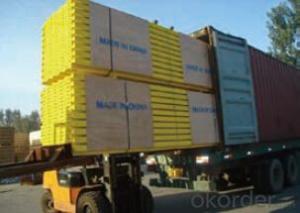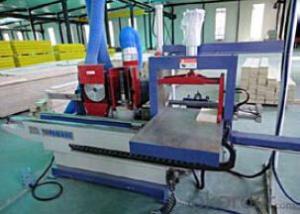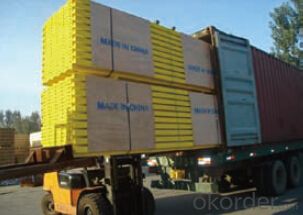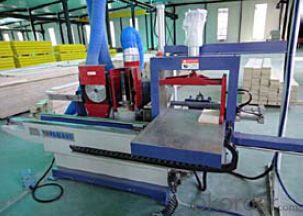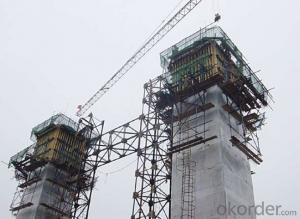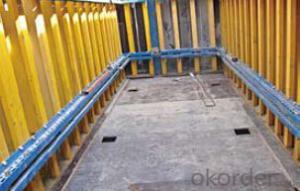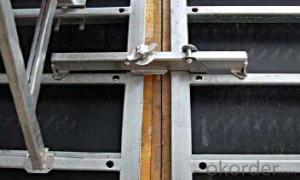Timber beam H20 for formwork and scaffolding system
- Loading Port:
- Tianjin
- Payment Terms:
- TT OR LC
- Min Order Qty:
- 50 m²
- Supply Capability:
- 1000 m²/month
OKorder Service Pledge
OKorder Financial Service
You Might Also Like
Characteristics:
◆ Standardized production lines.
Supply capability: 3000m/day, Lmax = 6600mm.
◆ Finger jointing of the flange and web, the strength of timber beam is highly improved.
Max. shearing force failure load:40KN
◆ Well treated to prevent from water penetration or erosion, so the service life maximally extended.
Normally, CNBM timber beam H20 can be used for 4 to 5 years, the exact using time would depend on maintenance & storage.
◆ Robust caps at the end of the girders protect against damages.
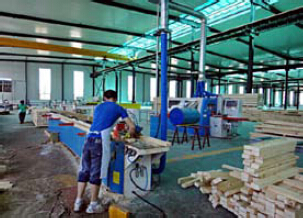
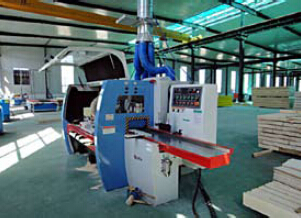

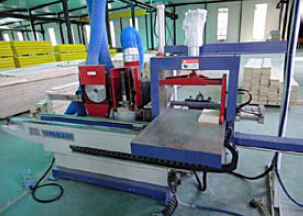
- Q: What are the different types of coatings used for steel formwork panels?
- There are several types of coatings commonly used for steel formwork panels, including epoxy, polyurethane, and galvanized coatings. Epoxy coatings provide excellent chemical resistance and durability, making them suitable for harsh environments. Polyurethane coatings offer good abrasion resistance and flexibility, making them ideal for formwork panels that require frequent reuse. Galvanized coatings provide corrosion protection by applying a layer of zinc on the steel surface, making them suitable for outdoor or high-moisture applications.
- Q: Can steel formwork be used for precast concrete wall panels?
- Precast concrete wall panels can indeed utilize steel formwork. Steel formwork boasts numerous advantages in precast concrete construction. With its high strength, durability, and dimensional accuracy, steel formwork guarantees the production of top-quality wall panels. Moreover, steel formwork can be easily reused multiple times, presenting a cost-effective solution. Additionally, its installation process is quick and efficient, leading to reduced construction time. The malleability of steel formwork allows for the creation of wall panels in various shapes and sizes, accommodating the design requirements of diverse projects. Consequently, steel formwork emerges as a fitting choice for precast concrete wall panels, offering an array of benefits in terms of strength, durability, efficiency, and cost-effectiveness.
- Q: What are the different safety guidelines for dismantling steel formwork?
- When dismantling steel formwork, it is important to follow certain safety guidelines to ensure the well-being of workers and prevent accidents. Some of the key safety guidelines include: 1. Adequate training: Workers involved in dismantling steel formwork should be properly trained in the safe dismantling procedures. They should be familiar with the equipment and tools used and understand the potential hazards associated with the task. 2. Personal protective equipment (PPE): All workers must wear appropriate PPE, including hard hats, safety glasses, gloves, and steel-toed boots, to protect themselves from falling objects, sharp edges, and other potential hazards. 3. Secure the area: Before starting the dismantling process, the work area should be properly secured and cordoned off to prevent unauthorized access. Warning signs and barriers should be placed to alert others about the ongoing work. 4. Inspection of equipment: The steel formwork and associated equipment should be inspected for any damage or defects before dismantling. Any faulty equipment should be repaired or replaced to ensure safe dismantling. 5. Proper tools and equipment: Use the correct tools and equipment for dismantling, such as wrenches, hammers, and cutting tools. Ensure that they are in good working condition and used correctly to avoid accidents. 6. Controlled dismantling: Dismantle the steel formwork in a controlled manner, starting from the top and working downwards. Avoid sudden movements or actions that may cause parts to fall or collapse. 7. Fall protection: Implement appropriate fall protection measures, such as safety harnesses and lanyards, when working at heights. Install guardrails or safety nets to minimize the risk of falls. 8. Communication and coordination: Maintain clear communication among workers involved in the dismantling process to ensure everyone is aware of the ongoing activities and potential hazards. Coordinate the work to avoid any conflicts or accidents. 9. Safe handling and disposal: When removing steel formwork components, ensure proper lifting techniques are used to avoid strains or injuries. Dispose of dismantled materials safely and responsibly, following local regulations. 10. Regular inspections: Regularly inspect the dismantled formwork components, storage areas, and tools to identify any potential safety hazards and address them promptly. It is crucial to prioritize safety during the dismantling process of steel formwork to prevent injuries, accidents, and damage to property.
- Q: How do steel formwork systems ensure proper alignment and stability?
- Steel formwork systems ensure proper alignment and stability through various features and design elements. Firstly, steel formwork systems are made of high-quality steel materials that offer excellent strength and durability. This ensures that the formwork maintains its shape and structure even under heavy loads and adverse weather conditions. Additionally, steel formwork systems often incorporate interlocking mechanisms and connecting devices that securely hold the formwork panels together. These connections provide a tight and precise alignment, ensuring that the formwork maintains its shape and prevents any movement or shifting during the concrete pouring process. Furthermore, steel formwork systems are typically designed with adjustable components, such as adjustable struts or props, which allow for easy and accurate leveling and alignment. These adjustable elements enable workers to fine-tune the formwork to the desired position and ensure a level and uniform concrete surface. Moreover, steel formwork systems often include diagonal bracing or cross-bracing elements that provide added stability and rigidity. These bracing elements help distribute the load evenly across the formwork, minimizing any potential sagging or deformation and ensuring the stability of the structure during the concrete pouring and curing process. Lastly, steel formwork systems are versatile and can be customized to fit various shapes and sizes. This flexibility allows for precise alignment to the desired form, ensuring that the concrete structure is constructed with the utmost accuracy and stability. In conclusion, steel formwork systems ensure proper alignment and stability through the use of high-quality materials, interlocking mechanisms, adjustable components, bracing elements, and customization options. These features work together to create a reliable and robust formwork system that guarantees the accurate and stable construction of concrete structures.
- Q: How does steel formwork contribute to the overall stability of the structure?
- Steel formwork contributes to the overall stability of a structure in several ways. Firstly, steel is a highly durable and strong material, making it capable of withstanding significant loads and pressures. This strength ensures that the formwork remains intact and stable during the construction process, even when exposed to heavy loads such as wet concrete. Secondly, steel formwork provides excellent dimensional stability. Unlike other materials like wood, steel does not warp or deform over time, ensuring that the structure maintains its desired shape and dimensions. This is crucial for the stability of the structure, as any deformation or movement in the formwork could lead to inaccuracies or weaknesses in the final construction. Moreover, steel formwork offers a high level of rigidity and stiffness. This rigidity helps to prevent any unwanted movement or shifting of the formwork during concrete pouring and curing, ensuring that the structure is built according to the intended design and specifications. It also helps distribute the weight and forces evenly, reducing the risk of structural failures or collapses. Additionally, steel formwork provides excellent support and reinforcement for the concrete. The steel panels and beams used in formwork act as a framework, holding the concrete in place until it hardens and gains its own strength. This support not only ensures the proper formation of the structure but also enhances its overall stability by preventing any concrete cracking or failure. Lastly, steel formwork is highly adaptable and can be easily customized to fit various architectural designs and construction requirements. This flexibility allows for the creation of complex and unique structures, while still maintaining stability and strength. In conclusion, steel formwork contributes significantly to the overall stability of a structure through its durability, dimensional stability, rigidity, support, and adaptability. Its robustness and ability to withstand heavy loads, combined with its ability to maintain shape and provide structural support, make it an essential component in ensuring the stability and integrity of any construction project.
- Q: What are the different types of edge protections available for steel formwork?
- There are several types of edge protections available for steel formwork, including steel edge angles, timber edge fillets, plastic edge profiles, and rubber edge guards. These edge protections are used to ensure the safety of workers by preventing them from accidentally stepping off the edge of the formwork.
- Q: How does steel formwork contribute to the fire resistance of the structure?
- Steel formwork, also referred to as steel molds or frames, plays a crucial role in enhancing the fire resistance of a structure. Primarily, steel possesses inherent fire-resistant properties due to its high melting point and low combustibility, making it an optimal choice for formwork in areas prone to fires. When steel formwork is employed in construction, it imparts strength and rigidity to the structure, thereby preserving its integrity during a fire. These steel molds securely hold the concrete in place, preventing its collapse or disintegration when exposed to elevated temperatures. This structural stability enables firefighters to enter the building safely and extinguish the fire without concerns of sudden structural failure. Furthermore, steel formwork acts as a heat sink during a fire by virtue of its high thermal conductivity. This characteristic facilitates the rapid absorption and dissipation of heat, thereby minimizing the spread of fire and reducing the overall temperature within the structure. By absorbing heat, steel formwork effectively delays the occurrence of concrete spalling or cracking, thereby maintaining the structural integrity of the building for an extended duration. In addition, steel formwork is often designed with appropriate fire-resistant coatings or insulation materials. These coatings provide an additional layer of protection against heat, flames, and smoke generated during a fire. They also aid in impeding or slowing down the transfer of heat to the concrete, thereby further augmenting the fire resistance of the structure. Overall, the utilization of steel formwork significantly enhances the fire resistance of a building by providing structural stability, functioning as a heat sink, and incorporating fire-resistant coatings or insulation materials. By incorporating steel molds, architects and engineers can ensure the safety and longevity of the structure, even in the event of a fire.
- Q: How does steel formwork affect the cost of construction?
- The overall cost of construction can be significantly influenced by steel formwork. Despite the need for a greater initial investment compared to traditional formwork materials like wood or plywood, steel formwork offers several advantages that can help counterbalance the increased cost. To begin with, steel formwork is highly durable and long-lasting, enabling it to be reused multiple times. Unlike wood or plywood formwork, steel formwork does not warp, rot, or deteriorate over time. This ability to be reused reduces the necessity for frequent formwork replacements, resulting in material cost savings in the long term. Moreover, steel formwork provides exceptional strength and stability, allowing for the construction of intricate and high-quality concrete structures. This strength permits the usage of thinner formwork elements, reducing the overall weight of the formwork system. Consequently, less labor and equipment are required for handling and installation, resulting in cost savings in terms of manpower and machinery. Furthermore, steel formwork facilitates faster construction cycles. The smooth and precise surface finish provided by steel formwork diminishes the need for extensive finishing work. This streamlined construction process saves time, ultimately reducing labor costs and project timelines. Additionally, steel formwork enhances safety on construction sites. Its robust nature and secure connections guarantee stability during concrete pouring and curing, minimizing the risk of accidents or structural failures. This improved safety aspect can help decrease insurance costs and potential legal liabilities. Lastly, steel formwork is highly adaptable and customizable. It can be easily modified and adjusted to accommodate various design requirements, making it suitable for a wide range of construction projects. This flexibility optimizes material usage and ensures minimal wastage, thereby reducing overall construction costs. In conclusion, although steel formwork may initially incur a higher cost, its long-term benefits such as reusability, strength, speed, safety, and adaptability contribute to overall cost savings in construction projects. Its durability and efficiency make it a cost-effective choice that can positively impact the quality, timeline, and budget of any construction undertaking.
- Q: How does steel formwork contribute to the overall durability of a structure?
- Steel formwork contributes to the overall durability of a structure by providing a strong and rigid framework during the concrete pouring process. It ensures accurate and precise shaping of the concrete, resulting in a solid and uniform structure. Steel formwork is highly resistant to warping, bending, and cracking, making it more durable than other types of formwork materials. Its strength and durability allow for multiple reuse, reducing construction costs and minimizing waste. Additionally, steel formwork provides excellent support for the concrete as it cures, preventing any deformation or collapse. Overall, steel formwork plays a crucial role in enhancing the longevity and robustness of a structure.
- Q: How does steel formwork affect the overall timeline of a construction project?
- The overall timeline of a construction project can be significantly influenced by the use of steel formwork. One of the main advantages of steel formwork is its durability and reusability. Unlike traditional timber formwork, steel formwork can be utilized multiple times, reducing the time required for constructing and dismantling formwork for each concrete pour. Furthermore, the strength and rigidity of steel formwork enable faster construction cycles. Its ability to withstand higher concrete pressure allows for quicker pouring and setting of concrete, resulting in shorter curing times. This, in turn, permits subsequent construction activities to commence earlier, ultimately accelerating the overall project timeline. Another noteworthy feature of steel formwork is its precision and dimensional stability. It provides a smooth and accurate surface finish, eliminating the need for additional plastering or leveling work. This saves time and reduces the number of construction activities required, thus further enhancing the project timeline. Moreover, steel formwork is typically prefabricated, meaning it is manufactured off-site and delivered ready for assembly at the construction site. This considerably reduces on-site construction time, as the formwork can be swiftly erected and adjusted to the desired shape and dimensions. This timely installation ensures that other trades can progress with their work without delays, ultimately speeding up the overall construction process. However, it is important to acknowledge that the initial setup time for steel formwork may be longer compared to other formwork types, as it necessitates careful planning and coordination. The formwork design must be accurately calculated, and any modifications or adjustments may require additional time. Nevertheless, the time saved during subsequent concrete pours and other construction activities usually compensates for this initial setup period. In conclusion, steel formwork has a positive impact on the overall timeline of a construction project by reducing the time spent on constructing and dismantling formwork, enabling faster concrete pouring and curing, providing a precise and finished surface, and facilitating quick and efficient on-site assembly. Its durability and reusability contribute to a more efficient and timely construction process, resulting in a shorter overall project duration.
Send your message to us
Timber beam H20 for formwork and scaffolding system
- Loading Port:
- Tianjin
- Payment Terms:
- TT OR LC
- Min Order Qty:
- 50 m²
- Supply Capability:
- 1000 m²/month
OKorder Service Pledge
OKorder Financial Service
Similar products
Hot products
Hot Searches
Related keywords
